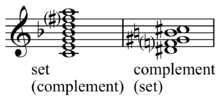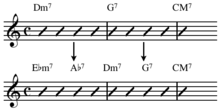Outside (jazz): Difference between revisions
m internal links |
|||
| Line 48: | Line 48: | ||
One technique used for sideslipping is the addition of distant [[ii-V-I turnaround|ii-V]] relationships, such as adding a ii-V a half-step above the original ii-V. This increases chromatic tension as it first moves away and then towards the tonic.<ref name="Lawn"/> |
One technique used for sideslipping is the addition of distant [[ii-V-I turnaround|ii-V]] relationships, such as adding a ii-V a half-step above the original ii-V. This increases chromatic tension as it first moves away and then towards the tonic.<ref name="Lawn"/> |
||
Examples of outside playing may be found in the work of [[John McLaughlin]], [[Miles Davis]], [[John Coltrane]], [[Wayne Shorter]], and [[Scott Henderson]], among others.<ref>Fisher, Jody (1995). ''Complete Jazz Guitar Method'', p.50. ISBN 9780739025901.</ref> |
Examples of outside playing may be found in the work of [[John McLaughlin (musician)|John McLaughlin]], [[Miles Davis]], [[John Coltrane]], [[Wayne Shorter]], and [[Scott Henderson]], among others.<ref>Fisher, Jody (1995). ''Complete Jazz Guitar Method'', p.50. ISBN 9780739025901.</ref> |
||
==See also== |
==See also== |
||
Revision as of 07:20, 11 November 2011



In jazz improvisation, to play outside, or out, is to intentionally stray from the key or chord changes of the song form. The term refers to a soloist taking some of the harmonic liberties of free jazz within a hard bop or modal context.[1] There are various approaches to outside playing, including "free" playing, as well as the superimposition of alternate harmonic material including side-stepping[2]. However, "having essentially the same meaning, these terms [side-slipping and outside playing] refer to events in a solo where the improviser is deliberately playing 'out-of-the-key' for the sake of creating tension".[3]
Side-slipping or side-stepping (planing, parallelism) is a type of outside playing in which a soloist super-imposes a scale a half-step above or below the "inside" or standard consonant scale for the given chord or key.[2][4]
In the example on the rhythm changes B section to the right, the (heptatonic) scale for each chord would be:
E7 - E mixolydian A7 - A mixolydian D7 - D mixolydian G7 - G mixolydian C - C major
Thus the non-scale notes, in this case a pentatonic scale based on a root note one half-step down, would be:
E7 - E♭ major pentatonic A7 - A♭ major pentatonic D7 - D♭ major pentatonic G7 - G♭ major pentatonic C - C♭ major pentatonic
One technique used for sideslipping is the addition of distant ii-V relationships, such as adding a ii-V a half-step above the original ii-V. This increases chromatic tension as it first moves away and then towards the tonic.[2]
Examples of outside playing may be found in the work of John McLaughlin, Miles Davis, John Coltrane, Wayne Shorter, and Scott Henderson, among others.[5]
See also
Sources
- ^ "Outside [out]", The New Grove Dictionary of Jazz;, vol. 2nd Edition, Oxford University Press, 2007
- ^ a b c Lawn, Richard and Hellmer, Jeffrey L. (1996). Jazz: Theory and Practice, p.119. ISBN 0882847228. This technique [adding a ii-V a halfstep above the original] is often employed by soloists as a form of "sideslipping," or "sidestepping," which is playing chromatically outside of the chord changes.
- ^ Coker, Jerry (1991). Elements of the jazz language for the developing improvisor, p.83. ISBN 9781576238752.
- ^ Morgan, David (2002). Annual Review of Jazz Studies, Volume 11. Superimposition in the Improvisations of Herbie Hancock: Scarecrow Press, Inc. p. 79. ISBN 0810845350.
Side slipping is defined [in Liebman, David (Advance: 1991). A Chromatic Approach to Jazz Harmony and Melody, p.173.] as a 'half-step up or down movement away from what is given melodically or harmonically.'
{{cite book}}: Unknown parameter|coauthors=ignored (|author=suggested) (help) - ^ Fisher, Jody (1995). Complete Jazz Guitar Method, p.50. ISBN 9780739025901.
